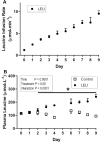A Chronic Fetal Leucine Infusion Potentiates Fetal Insulin Secretion and Increases Pancreatic Islet Size, Vascularity, and β Cells in Late-Gestation Sheep
- PMID: 32470982
- PMCID: PMC7398779
- DOI: 10.1093/jn/nxaa138
A Chronic Fetal Leucine Infusion Potentiates Fetal Insulin Secretion and Increases Pancreatic Islet Size, Vascularity, and β Cells in Late-Gestation Sheep
Abstract
Background: Infusion of a complete amino acid mixture into normal late-gestation fetal sheep potentiates glucose-stimulated insulin secretion (GSIS). Leucine acutely stimulates insulin secretion in late-gestation fetal sheep and isolated fetal sheep islets in vitro.
Objectives: We hypothesized that a 9-d leucine infusion would potentiate GSIS in fetal sheep.
Methods: Columbia-Rambouillet fetal sheep at 126 days of gestation received a 9-d leucine infusion to achieve a 50%-100% increase in leucine concentrations or a control infusion. At the end of the infusion we measured GSIS, pancreatic morphology, and expression of pancreatic mRNAs. Pancreatic islet endothelial cells (ECs) were isolated from fetal sheep and incubated with supplemental leucine or vascular endothelial growth factor A (VEGFA) followed by collection of mRNA. Data measured at multiple time points were compared with a repeated-measures 2-factor ANOVA. Data measured at 1 time point were compared using Student's t test or the Mann-Whitney test.
Results: Glucose-stimulated insulin concentrations were 80% higher in leucine-infused (LEU) fetuses than in controls (P < 0.05). In the pancreas, LEU fetuses had a higher proportion of islets >5000 μm2 than controls (75% more islets >5000 μm2; P < 0.05) and a larger proportion of the pancreas that stained for β cells (12% greater; P < 0.05). Pancreatic and pancreatic islet vascularity were both 25% greater in LEU fetuses (P < 0.05). Pancreatic VEGFA and hepatocyte growth factor (HGF) mRNA expressions were 38% and 200% greater in LEU fetuses than in controls (P < 0.05), respectively. In isolated islet ECs, HGF mRNA was 20% and 50% higher after incubation in supplemental leucine (P < 0.05) or VEGFA (P < 0.01), respectively.
Conclusions: A 9-d leucine infusion potentiates fetal GSIS, demonstrating that glucose and leucine act synergistically to stimulate insulin secretion in fetal sheep. A greater proportion of the pancreas being comprised of β cells and higher pancreatic vascularity contributed to the higher GSIS.
Keywords: VEGFA; fetus; hepatocyte growth factor; insulin; islet; leucine; pancreas; pregnancy; vascularity; β cell.
Copyright © The Author(s) on behalf of the American Society for Nutrition 2020.
Figures





Similar articles
-
Leucine acutely potentiates glucose-stimulated insulin secretion in fetal sheep.J Endocrinol. 2020 Oct;247(1):115-126. doi: 10.1530/JOE-20-0243. J Endocrinol. 2020. PMID: 32756000 Free PMC article.
-
Chronic Fetal Leucine Infusion Does Not Potentiate Glucose-Stimulated Insulin Secretion or Affect Pancreatic Islet Development in Late-Gestation Growth-Restricted Fetal Sheep.J Nutr. 2021 Feb 1;151(2):312-319. doi: 10.1093/jn/nxaa357. J Nutr. 2021. PMID: 33326574 Free PMC article.
-
Reduced glucose-stimulated insulin secretion following a 1-wk IGF-1 infusion in late gestation fetal sheep is due to an intrinsic islet defect.Am J Physiol Endocrinol Metab. 2021 Jun 1;320(6):E1138-E1147. doi: 10.1152/ajpendo.00623.2020. Epub 2021 May 3. Am J Physiol Endocrinol Metab. 2021. PMID: 33938236 Free PMC article.
-
Chronic late gestation fetal hyperglucagonaemia results in lower insulin secretion, pancreatic mass, islet area and beta- and α-cell proliferation.J Physiol. 2024 Nov;602(22):6329-6345. doi: 10.1113/JP286974. Epub 2024 Oct 9. J Physiol. 2024. PMID: 39383208
-
Emerging Nano- and Micro-Technologies Used in the Treatment of Type-1 Diabetes.Nanomaterials (Basel). 2020 Apr 20;10(4):789. doi: 10.3390/nano10040789. Nanomaterials (Basel). 2020. PMID: 32325974 Free PMC article. Review.
Cited by
-
Tissue-specific responses that constrain glucose oxidation and increase lactate production with the severity of hypoxemia in fetal sheep.Am J Physiol Endocrinol Metab. 2022 Feb 1;322(2):E181-E196. doi: 10.1152/ajpendo.00382.2021. Epub 2021 Dec 27. Am J Physiol Endocrinol Metab. 2022. PMID: 34957858 Free PMC article.
-
Chronic Fetal Leucine Infusion Increases Rate of Leucine Oxidation but Not of Protein Synthesis in Late Gestation Fetal Sheep.J Nutr. 2023 Feb;153(2):493-504. doi: 10.1016/j.tjnut.2022.12.027. Epub 2022 Dec 30. J Nutr. 2023. PMID: 36894241 Free PMC article.
-
Fetal Sex Does Not Impact Placental Blood Flow or Placental Amino Acid Transfer in Late Gestation Pregnant Sheep With or Without Placental Insufficiency.Reprod Sci. 2022 Jun;29(6):1776-1789. doi: 10.1007/s43032-021-00750-9. Epub 2021 Oct 5. Reprod Sci. 2022. PMID: 34611848 Free PMC article.
-
Leucine acutely potentiates glucose-stimulated insulin secretion in fetal sheep.J Endocrinol. 2020 Oct;247(1):115-126. doi: 10.1530/JOE-20-0243. J Endocrinol. 2020. PMID: 32756000 Free PMC article.
-
RISING STARS: Mechanistic insights into maternal-fetal cross talk and islet beta-cell development.J Endocrinol. 2023 Nov 8;259(3):e230069. doi: 10.1530/JOE-23-0069. Print 2023 Dec 1. J Endocrinol. 2023. PMID: 37855321 Free PMC article. Review.
References
-
- Fowden AL. Effects of adrenaline and amino acids on the release of insulin in the sheep fetus. J Endocrinol. 1980;87:113–21. - PubMed
-
- Gresores A, Anderson S, Hood D, Zerbe GO, Hay WW Jr. Separate and joint effects of arginine and glucose on ovine fetal insulin secretion. Am J Physiol. 1997;272:E68–73. - PubMed
-
- Philipps AF, Dubin JW, Raye JR. Alanine-stimulated insulin secretion in the fetal and neonatal lamb. Am J Obstet Gynecol. 1980;136:597–602. - PubMed
-
- Rozance PJ, Limesand SW, Hay WW Jr. Decreased nutrient-stimulated insulin secretion in chronically hypoglycemic late-gestation fetal sheep is due to an intrinsic islet defect. Am J Physiol Endocrinol Metab. 2006;291:E404–11. - PubMed

